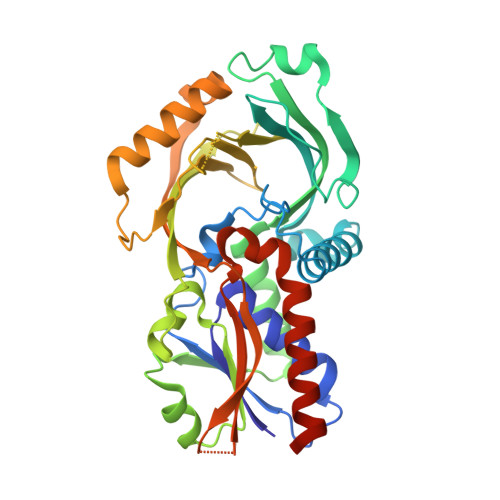Novel human D-amino acid oxidase inhibitors stabilize an active-site lid-open conformation.
Terry-Lorenzo, R.T., Chun, L.E., Brown, S.P., Heffernan, M.L., Fang, Q.K., Orsini, M.A., Pollegioni, L., Hardy, L.W., Spear, K.L., Large, T.H.(2014) Biosci Rep 34
- PubMed: 25001371
- DOI: https://doi.org/10.1042/BSR20140071
- Primary Citation of Related Structures:
4QFC, 4QFD - PubMed Abstract:
The NMDAR (N-methyl-D-aspartate receptor) is a central regulator of synaptic plasticity and learning and memory. hDAAO (human D-amino acid oxidase) indirectly reduces NMDAR activity by degrading the NMDAR co-agonist D-serine. Since NMDAR hypofunction is thought to be a foundational defect in schizophrenia, hDAAO inhibitors have potential as treatments for schizophrenia and other nervous system disorders. Here, we sought to identify novel chemicals that inhibit hDAAO activity. We used computational tools to design a focused, purchasable library of compounds. After screening this library for hDAAO inhibition, we identified the structurally novel compound, 'compound 2' [3-(7-hydroxy-2-oxo-4-phenyl-2H-chromen-6-yl)propanoic acid], which displayed low nM hDAAO inhibitory potency (Ki=7 nM). Although the library was expected to enrich for compounds that were competitive for both D-serine and FAD, compound 2 actually was FAD uncompetitive, much like canonical hDAAO inhibitors such as benzoic acid. Compound 2 and an analog were independently co-crystalized with hDAAO. These compounds stabilized a novel conformation of hDAAO in which the active-site lid was in an open position. These results confirm previous hypotheses regarding active-site lid flexibility of mammalian D-amino acid oxidases and could assist in the design of the next generation of hDAAO inhibitors.
Organizational Affiliation:
*Discovery Research Department, Sunovion Pharmaceuticals, Marlborough, MA 01752, U.S.A.

















